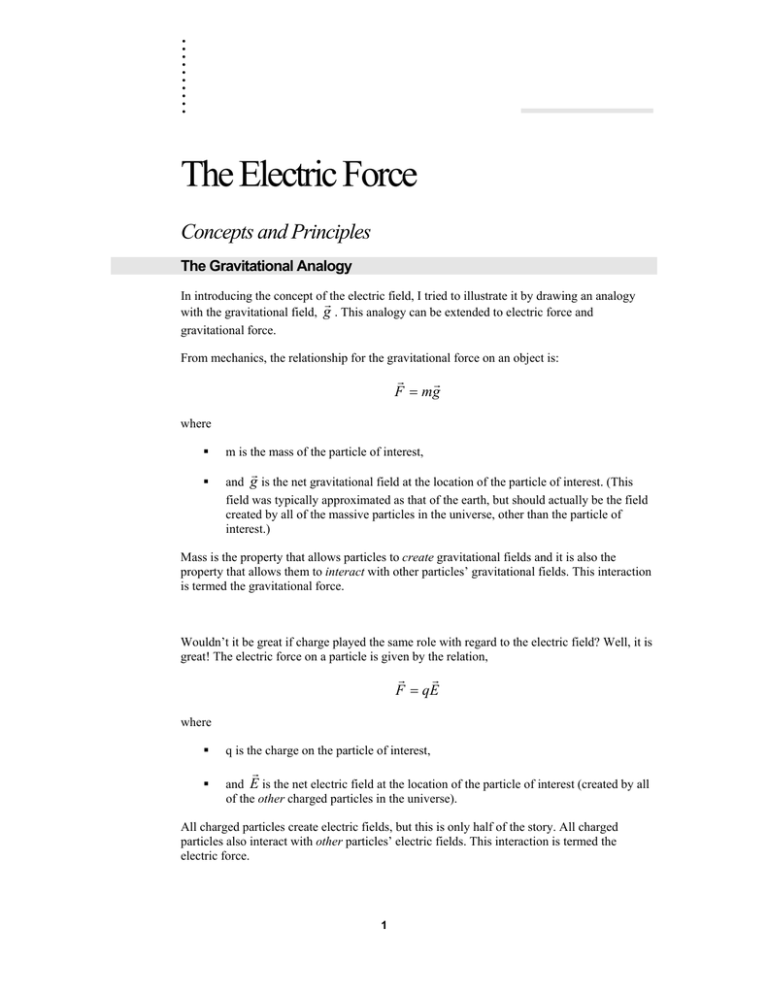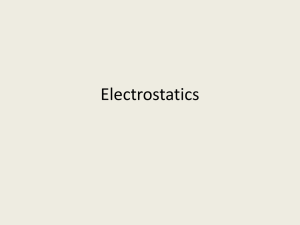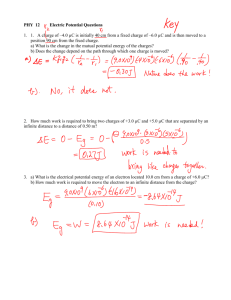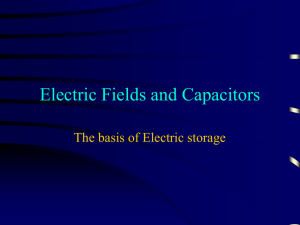The Electric Force
advertisement

.. .. .. .. .. The Electric Force Concepts and Principles The Gravitational Analogy In introducing the concept of the electric field, I tried to illustrate it by drawing an analogy with the gravitational field, g . This analogy can be extended to electric force and gravitational force. From mechanics, the relationship for the gravitational force on an object is: F mg where m is the mass of the particle of interest, and g is the net gravitational field at the location of the particle of interest. (This field was typically approximated as that of the earth, but should actually be the field created by all of the massive particles in the universe, other than the particle of interest.) Mass is the property that allows particles to create gravitational fields and it is also the property that allows them to interact with other particles’ gravitational fields. This interaction is termed the gravitational force. Wouldn’t it be great if charge played the same role with regard to the electric field? Well, it is great! The electric force on a particle is given by the relation, F qE where q is the charge on the particle of interest, and E is the net electric field at the location of the particle of interest (created by all of the other charged particles in the universe). All charged particles create electric fields, but this is only half of the story. All charged particles also interact with other particles’ electric fields. This interaction is termed the electric force. 1 .. .. .. .. .. The Electric Force Analysis Tools Point Charges The three charges at right are located as shown. Each grid square has width a. Find the net electric force on the positive charge. -2q +2q -q To find the electric force on the positive charge, you must first find the electric field at its location in space. Thus, this is really just more practice in calculating the electric field! The electric field at the location of the positive charge will be the vector sum of the electric field from the –2q charge (E-2q) and the electric field from the -q charge (E-q). Let’s calculate these two fields separately and then add them together. From the -2q charge: kq E 2 q 2 rˆ r (4a )iˆ ( a ) ˆj k ( 2 q ) ( ) E2q ( 4a ) 2 ( a ) 2 ( 4a ) 2 ( a ) 2 2kq (4aiˆ aˆj ) E2q (17 a 2 ) 3 / 2 2kq E 2 q 3 / 2 2 (4iˆ ˆj ) 17 a kq E 2 q (0.114iˆ 0.0285 ˆj ) 2 a 2 and from the +2q charge: kq E q 2 rˆ r (3a )iˆ (a ) ˆj k (q) ( ) E q (3a ) 2 (a ) 2 (3a ) 2 (a ) 2 kq (3aiˆ aˆj ) E q 2 3/ 2 (10a ) kq E q 3 / 2 2 (3iˆ ˆj ) 10 a kq E q (0.0949iˆ 0.0316 ˆj ) 2 a Adding these two contributions together yields kq E (0.209iˆ 0.0031 ˆj ) 2 a So the force on the positive charge is: F qE kq F (2q )(0.209iˆ 0.0031 ˆj ) 2 a 2 kq F (0.418iˆ 0.0062 ˆj ) 2 a The force on the positive charge is to the left, and slightly downward, attracted to the two negative charges. 3 Force and Motion In many applications, oppositely charged parallel plates are used to “steer” beams of charged particles. In this example, a proton is injected at 2.0 x 106 m/s into the space between the plates. The plates are 2.0 cm long. What charge density is needed on the plates to give the proton a y-velocity of 2.0 x 105 m/s as it exits the plates? Since this problem involves the motion of a particle between two distinct events, let’s complete a motion table. Event 1: The proton enters the device. Event 2: The proton exits the device. t1 = 0 s t2 = r1x = 0 m r2x = 0.02 m r1y = 0 m r2y = 6 v1x = 2 x 10 m/s v2x = v1y = 0 m/s v2y = 2 x 105 m/s a12x = 0 m/s2 a12y = Between the plates, the proton will experience an electrical force, and hence acceleration, in the y-direction. Remember from mechanics that this y-acceleration will not affect the kinematics of the proton in the x-direction. Thus, in the x-direction the acceleration of the proton is zero. Applying the kinematic equations in the x-direction yields: v 2 v1 a12 (t 2 t1 ) v 2 x (2 x10 ) 0(t 2 0) 6 v 2 x 2 x10 6 m / s 1 a12 (t 2 t1 ) 2 2 1 0.02 0 (2 x10 6 )(t 2 0) (0)(t 2 0) 2 2 8 t 2 1x10 s r2 r1 v1 (t 2 t1 ) Applying the same kinematic equations in the y-direction yields: v2 v1 a12 (t2 t1 ) r2 r1 v1 (t 2 t1 ) 8 2 x10 0 a y (1x10 0) 5 1 (2 x10 13 )(1x10 8 0) 2 2 0.001m r2 y 0 0 a y 2 x1013 m / s 2 r2 y 4 1 a12 (t 2 t1 ) 2 2 Now, using Newton’s Second Law and the relation for electric field from parallel conducting plates, find the necessary charge density. F ma qE mg ma q( ) mg ma 0 (ma mg ) 0 q ((1.67 x 10 -27 )(2.0 x 1013 ) (1.67 x 10 -27 )(9.8))(8.85 x 10 -12 ) (1.6 x 10 -19 ) 1.85C / m 2 The bottom plate should be made positive and the top plate negative, both with this charge density. (Note that the gravitational force acting on the proton is completely insignificant compared to the electrical force. This is generally true and we will typically ignore the gravitational force acting on individual particles such as protons and electrons.) 5 .. .. .. .. .. The Electric Force Activities 6 Determine the direction of the net electric force on each charge. a. +q -q -q b. -q -q +q c. +q -q -2q d. -q +q -2q -q -q -2q e. 7 Determine the direction of the net electric force on each charge. b. a. +q +2q -q -q +q +q d. c. +q -q -q -q -q -q +q -q 8 Below are free-body diagrams for three electric charges that lie along a straight line. Determine the relative positions, with correct spacing, of the three charges. a. +q -q +q b. -q -q +q 9 Below are free-body diagrams for three electric charges that lie in the same plane. Determine the relative positions, with correct spacing, of the three charges. a. -q -q +q b. +2q +q -2q 10 Below are free-body diagrams for three electric charges that lie in the same plane. Determine the relative positions, with correct spacing, of the three charges. a. -2q -q +q b. +q +q -q 11 A uniform electric field fills a region of space. In each of the regions, a charged particle (either a proton or an electron) enters the region with an initial velocity. The subsequent path of the particle is indicated by sequential velocity vectors. Indicate the direction of the electric field vector in each region of space. b. a. -e +e d. c. +e +e f. e. +e -e g. h. -e -e 12 For each of the six combinations of electric charges listed below, rank the combinations on the basis of the electric force acting on the central charge. Forces pointing to the right are positive. q1 q1 A 1 nC B 1 nC C -1 nC D 1 nC E 2 nC F 2 nC q2 q3 q2 q3 1 nC -1 nC 1 nC 2 nC 1 nC 1 nC 1 nC 1 nC 1 nC -1 nC 2 nC -2 nC C DF ABE Largest Positive 1. _____ 2. _____ 3. _____ 4. _____ 5. _____ 6. _____ Largest Negative _____ The ranking cannot be determined based on the information provided. Explain the reason for your ranking: The electric field at the location of the central charge is obviously zero in scenarios A, B and E. Therefore the force acting on the central charge in those scenarios must be zero. In C, the net electric field is negative, so the force acting on the positive central charge is also negative. In D and F the field is positive, so the force on the central charge is positive in both scenarios. If F, the field is twice as large as in D, but since the central charge is half as large, the electric force in D and F are actually equal. If you prefer a more mathematical solution, I could let a equal the distance btwn adjacent charges and write: kq kq kiˆ F2 q 2 ( E1 E3 ) q 2 ( 21 iˆ 23 (iˆ)) 2 [q 2 (q1 q3 )] a a a Ignoring the constant factor out front leads to: F2 q 2 (q1 q3 ) Therefore I can simply subtract q 3 from q1 and multiply the result by q 2 to get the correct ranking. 13 For each of the six combinations of electric charges listed below, rank the combinations on the basis of the electric force acting on the central charge. Forces pointing to the right are positive. q1 q1 A 1 nC B 1 nC C -1 nC D 2 nC E 2 nC F 2 nC q2 q3 q2 q3 1 nC 1 nC 1 nC 2 nC 1 nC 1 nC 1 nC 2 nC -4 nC 4 nC 2 nC -8 nC Largest Positive 1. _____ 2. _____ 3. _____ 4. _____ 5. _____ 6. _____ Largest Negative _____ The ranking cannot be determined based on the information provided. Explain the reason for your ranking: 14 For each of the six combinations of electric charges listed below, the electric force acting on the central charge is zero. Rank the combinations on the basis of q3. q1 q2 q3 q1 A B C D E F 1 nC 1 nC -1 nC 2 nC 2 nC 1 nC q2 1 nC -1 nC 1 nC 2 nC 1 nC 2 nC Largest Positive 1. _____ 2. _____ 3. _____ 4. _____ 5. _____ 6. _____ Largest Negative _____ The ranking cannot be determined based on the information provided. Explain the reason for your ranking: 15 For each of the six combinations of electric charges listed below, rank the combinations on the basis of the electric force acting on the left charge. Forces pointing to the right are positive. q1 q1 A 1 nC B 1 nC C 1 nC D 1 nC E -1 nC F 1 nC q2 q3 q2 q3 1 nC -1 nC 1 nC -1 nC 1 nC -2 nC 1 nC -1 nC -2 nC 4 nC -4 nC -4 nC Largest Positive 1. _____ 2. _____ 3. _____ 4. _____ 5. _____ 6. _____ Largest Negative _____ The ranking cannot be determined based on the information provided. Explain the reason for your ranking: 16 For each of the six combinations of electric charges listed below, the electric force acting on the left charge is zero. Rank the combinations on the basis of q3. q1 q2 q3 q1 A B C D E F 1 nC 1 nC -1 nC 2 nC 2 nC 1 nC q2 1 nC -1 nC 1 nC 2 nC 1 nC 2 nC Largest Positive 1. _____ 2. _____ 3. _____ 4. _____ 5. _____ 6. _____ Largest Negative _____ The ranking cannot be determined based on the information provided. Explain the reason for your ranking: 17 Below are six configurations of three electric charges. A B +q +q C +q +q D -q -q +q E +q +2q +q F +2q -q +q +2q +q +2q +q -q a. Rank these configurations on the magnitude of the electric force on the lower-left charge. Largest 1. _____ 2. _____ 3. _____ 4. _____ 5. _____ 6. _____ Smallest _____ The ranking cannot be determined based on the information provided. b. Rank these configurations on the basis of the angle the electric force acting on the lower-left charge makes with the +x-axis. Measure angles counterclockwise from the +x-axis. Largest 1. _____ 2. _____ 3. _____ 4. _____ 5. _____ 6. _____ Smallest _____ The ranking cannot be determined based on the information provided. Explain the reason for your rankings: 18 A sodium ion (Na+) and a chloride ion (Cl-) are separated by 2.82 x 10-10 m. Find the electric force on each ion. Na+ Cl- Qualitative Analysis On the graphic above, sketch the direction of the electric force on each charge. How should the electric force on the sodium ion compare to the electric force on the chloride ion? Explain. Mathematical Analysis 19 Find the electric force on each of the atoms in the chain of sodium ions (Na+) and chloride ions (Cl-). The interionic separation is 2.82 x 10-10 m. Cl- Na+ Cl- Qualitative Analysis On the graphic above, sketch the direction of the electric force on each charge. How should the electric force on the rightmost sodium ion compare to the electric force on the leftmost chloride ion? Explain. Mathematical Analysis 20 Na+ Find the electric force on each of the atoms in the sodium chloride “crystal”. The interionic separation is 2.82 x 10-10 m. Cl- Na+ Na+ Cl- Qualitative Analysis On the graphic above, sketch the direction of the electric force on each charge. How should the electric force on the upper-right sodium ion compare to the electric force on the lower-left sodium ion? Explain. Mathematical Analysis 21 The two positive charges are separated by a distance 2a. The negative charge is located at (x, y) = (0, 2a). Find the net electric force on each charge. -2q +q +q Qualitative Analysis On the graphic above, sketch the direction of the electric force on each charge. How should the electric force on the left positive charge compare to the electric force on the right positive charge? Explain. Mathematical Analysis 22 The three charges at right are located as shown. Each grid square has width a. Find the net electric force on the negative charge. -2q +q +q Qualitative Analysis On the graphic above, sketch the direction of the electric force on the negative charge. Mathematical Analysis 23 The three charges at right are located as shown. Each grid square has width a. Find the net electric force on the negative charge. +q +2q -q Qualitative Analysis On the graphic above, sketch the direction of the electric force on the negative charge. Mathematical Analysis 24 In the Bohr model of the hydrogen atom, the ground state of hydrogen consists of a proton encircled by an electron at radius a0. All allowed orbits exist at radii given by n2 a0, where n is the orbit number (1, 2, 3, etc.). a0, termed the Bohr radius, is equal to 5.29x10-11m. Mathematical Analysis a. Determine the magnitude of the electric force acting on the electron as a function of the electrostatic constant (k), the elementary charge (e), the orbit number (n), and the ground state radius (a0). Felectron q electron E fromproton e( ke ke 2 ) 2 (n 2 a0 ) 2 n 4 a0 b. Assuming the electron travels in a circular orbit around the proton, determine the speed of the electron as a function of the above parameters and the mass of the electron (m). For circular motion, v2 F m r 2 ke v2 m 2 n 2 a0 n 4 a0 v ke 2 mn 2 a 0 c. Based on your function, in which orbit does the electron have the largest speed? The largest speed occurs in the n = 1 orbit, the ground state. d. What is the value of the electron’s speed in this orbit? (9 x10 9 )(1.6 x10 19 ) 2 v (9.11x10 31 )(1) 2 (5.29 x10 11 ) v 2.2 x10 6 m / s 25 In the Bohr model of the hydrogen atom, the ground state of hydrogen consists of a proton encircled by an electron with separation 5.29 x 10-11 m. However, since the same magnitude force that acts on the electron also acts on the proton, the proton will also move in a circular orbit, but with a much smaller speed and a much smaller radius. Note that the period of revolution of the two particles is the same. The diagram at right is not to scale, since the proton’s orbital radius is insignificant compared to the electron’s orbital radius. -e 5.29 x 10-11 m +p Mathematical Analysis a. What is the magnitude of the electric force acting on the electron? b. Assuming the electron travels in a circular orbit around the (approximately stationary) proton, what is the speed of the electron? c. What is the period of the electron’s orbit? d. What is the radius and velocity of the proton’s orbit? 26 In alpha decay, an alpha particle (a bound state of 2 protons and 2 neutrons) escapes from a heavy nucleus and is propelled away due to electrical repulsion. For example, a radon nucleus (atomic number 86) will spontaneously transform into a polonium nucleus (atomic number 84) and an alpha particle. Immediately following this transformation, both the polonium nucleus and the alpha particle can be assumed to be at rest, and separated by approximately 50 x 10-15 m. Mathematical Analysis a. What is the electric force acting on the alpha particle? b. What is the initial acceleration of the alpha particle? c. As the alpha moves away from the polonium, the electric force decreases. Determine the velocity of the alpha when it is very far from the polonium by equating the work down by the electric force to the change in the alpha’s kinetic energy. Since the polonium is much more massive than the alpha, assume the polonium stays approximately at rest. 27 In an attempt to achieve nuclear fusion, a proton is fired at a fixed deuterium nucleus. (Deuterium is an isotope of hydrogen with one proton and one neutron in the nucleus.) If the distance of closest approach between the proton and the deuterium nucleus is about 1.0 x 10-15 m, the proton and deuterium have a good chance of fusing. Mathematical Analysis a. What is the electric force acting on the proton at the distance of closest approach? b. As the proton moves toward the deuterium, the electric force increases and the proton slows down. Determine the initial launch velocity of the proton when it is very far from the deuterium by equating the work down by the electric force to the change in the proton’s kinetic energy. Assume the proton travels directly toward the deuterium and momentarily “stops” at the distance of closest approach. c. If deuterium was launched at a fixed target of protons, rather than vice-versa, what launch velocity would be needed for the deuterium and protons to undergo fusion? 28 In many applications, oppositely charged parallel plates (with small holes cut for the beam to pass through) are used to accelerate beams of charged particles. In this example, electrons drift into the space between the plates. The plates are 5.0 cm apart. Mathematical Analysis a. If the electron exits the device at 2.0 x 106 m/s, what is the charge density on each plate? b. If the charge density on each plate was doubled, what would be the exit speed of the electrons? c. If the separation between the plates was doubled (with the original charge density), what would be the exit speed of the electrons? 29 In many applications, oppositely charged parallel plates (with small holes cut for the beam to pass through) are used to accelerate beams of charged particles. In this example, a proton is injected at 2.0 x 106 m/s into the space between the plates. The plates have charge density 1.0 C/m2, with the left plate positive, and are 5.0 cm apart. Mathematical Analysis a. What is the velocity of the proton as it exits the device? b. If a second, identical device was placed directly after the first, what would be the speed of the protons as they exit the second device? Why do the protons not increase their speed by the same amount in each device? c. Return to a single device. If the polarity of the plates was switched, what would be the exit speed of the protons? 30 In many applications, oppositely charged parallel plates are used to “suspend” charged particles. In this example, a dust grain with net charge +1.5 pC is suspended between the plates. The plates have charge density 1.0 C/m2, with the bottom plate positive. Mathematical Analysis a. What is the mass of the suspended dust grain? b. Other grains of dust would also be suspended by this device. For example, if a dust grain had twice the mass of the original grain and was also suspended, what would be the charge of this other grain? c. What is the charge-to-mass ratio (m/q) of all of the suspended dust grains? 31 In many applications, oppositely charged parallel plates are used to “suspend” charged particles. Imagine an oil droplet of radius R and mass density M suspended between the plates. The plates have charge density , with the bottom plate positive. Mathematical Analysis a. Determine the charge on the oil droplet as a function of its mass density, its radius, the charge density on the plates, the gravitational field strength (g), and the permittivity of free space (0). b. What is the charge on a suspended oil droplet of radius 1.8 m and density 0.835 g/cm3. The plates have charge density 1.0 C/m2. 32 In many applications, oppositely charged parallel plates are used to “steer” beams of charged particles. In this example, a proton is injected at 2.0 x 106 m/s into the space between the plates. The plates have charge density 1.0 C/m2, with the bottom plate positive, and are 2.0 cm long. What is the position and velocity of the proton as it exits the device? Motion Information Mathematical Analysis Event 1: Event 2: t1 = t2 = r1x = r2x = r1y = r2y = v1x = v2x = v1y = v2y = a12x = a12y = 33 In many applications, oppositely charged parallel plates are used to “steer” beams of charged particles. In this example, a proton is injected at 2.0 x 106 m/s into the space directly between the plates. The plates have charge density 1.0 C/m2, with the bottom plate positive, are 0.1 cm apart, and are very long. What is the position and velocity of the proton as it strikes the top plate? Motion Information Mathematical Analysis Event 1: Event 2: t1 = t2 = r1x = r2x = r1y = r2y = v1x = v2x = v1y = v2y = a12x = a12y = 34 In many applications, oppositely charged parallel plates are used to “steer” beams of charged particles. In this example, an electron is injected at 2.0 x 107 m/s into the space between the plates. The plates have charge density 5.0 C/m2, with the bottom plate positive, and are 2.0 cm long. 20 cm from the end of the plates is a phosphorescent screen. Where on the screen does the electron strike? Motion Information Event 1: Event 2: Event 3: t1 = t2 = t3 = r1x = r2x = r3x = r1y = r2y = r3y = v1x = v2x = v3x = v1y = v2y = v3y = a12x = a23x = a12y = a23y = Mathematical Analysis 35 36




